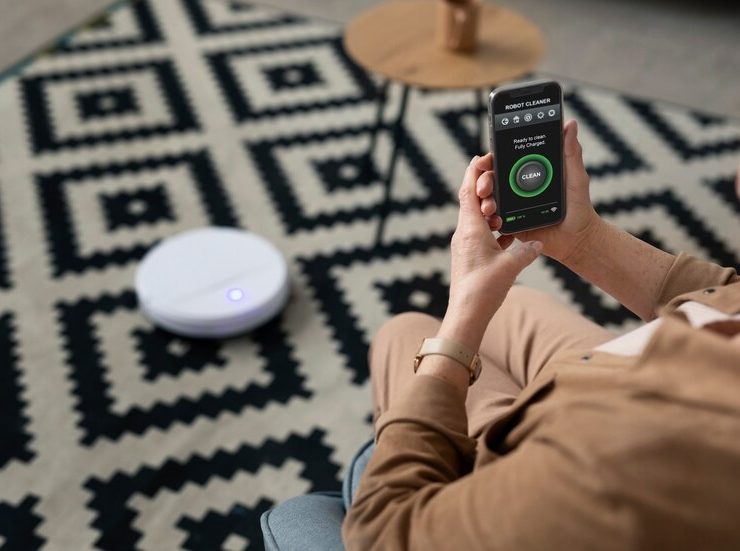Unlocking the Future: Your Simple Guide to Transforming Your Home into a Smart Haven
Are you tired of living in a home that feels more like a museum than a futuristic sanctuary? Well, it’s time to bring your living space into the 21st century without breaking the bank! In this guide, we’ll walk you through manageable steps to turn your ordinary abode into a smart home that caters to your every need. Whether you’re a tech whiz or someone who still struggles with the TV remote, there’s something here for everyone. From voice-controlled assistants that can dim your lights to smart thermostats that keep your home cozy without skyrocketing your energy bill, we’ve got you covered. Get ready to kickstart your smart home journey with ease and style!
Understanding What a Smart Home Is
Before diving into gadgets, let’s unpack what a smart home actually is. In simple terms, a smart home integrates technology into your living space to enhance convenience, security, and energy efficiency. Imagine controlling your lights, thermostat, and security cameras from your smartphone or with your voice. This is the magic of a smart home!
The internet of things (IoT) is the backbone of smart homes. Devices interconnected via the internet can communicate with each other to perform tasks seamlessly. This means you can set your coffee maker to brew just as your alarm goes off or receive push notifications on your phone if someone is at your door. It’s as exciting as it gets!
Assessing Your Needs and Budget
Before purchasing any gadgets, take a moment to assess your needs. What aspects of your home could benefit the most from smart technology? Is it security, energy savings, or maybe convenience? Creating a list of priorities will guide your purchases.
Now, let’s talk about the budget. You don’t need to spend a fortune to make your home smart. Understanding your financial limits will help you pick the best devices without regret. Consider starting small—after all, it’s easier to add gadgets over time than to buy everything at once!
Starting with a Smart Assistant
One of the best places to start your smart home journey is with a smart assistant like Amazon Echo or Google Nest Hub. These devices are user-friendly and can act as the central hub for your smart home ecosystem. They provide voice commands to control other devices and can even manage reminders and play your favorite music.
These assistants often have budgets around $50 to $150, making them a relatively low-cost entry point into smart home technology. Once you have your assistant set up, you’ll find it becomes your go-to for controlling other devices!
Smart Plugs for Instant Smartness
One of the easiest ways to make your existing appliances work smarter is by using smart plugs. These nifty little devices can convert any regular device into a smart one. All you need to do is plug it in and connect it to your Wi-Fi network.
Imagine turning on your coffee maker from bed or scheduling your lamps to turn on at sunset. The cost ranges from $10 to $30 each, making it an affordable and efficient way to dip your toes into the smart home waters.
Enhancing Security Without Breaking the Bank
Home security shouldn’t come with a hefty price tag. Smart cameras and doorbells are great for keeping an eye on your home. Models like Ring or Wyze offer compact versions that are easy to install yourself. They allow you to access live feeds and receive alerts on your phone when motion is detected.
Budget-friendly security cameras are typically available for under $100, and some even come with free cloud storage for recordings. You’ll gain peace of mind without spending a fortune!
Smart Lighting: A Mood Setter
When it comes to transforming your home atmosphere, smart lighting is a game changer. Smart bulbs allow you to control brightness and even change colors—all from your phone or with your voice. The Philips Hue and Wyze bulbs are excellent options that offer versatility at an affordable price.
Installing smart bulbs is as easy as replacing your average light bulbs. Many smart lighting solutions start around $15 per bulb. They can create moods, enhance productivity, or help you unwind—all with just a simple command!
Temperature Control Made Easy
Heating and cooling constitute a large portion of home energy expenses. Smart thermostats like the Nest Thermostat or Ecobee can help offset these costs. These devices learn your habits and automatically adjust the temperature based on your daily routines.
By using a smart thermostat, you can also control your home’s climate remotely. Thermostats typically range from $100 to $250, and the potential savings on your energy bills can quickly offset the cost.
Smart Sensors for Enhanced Awareness
While you’re at it, consider integrating smart sensors! These small devices can monitor motion, temperature, humidity, and even leaks. They can alert you in real-time if an unexpected situation arises, like a water leak in the basement or a sudden drop in temperature.
Smart sensors start as low as $20, making them an affordable addition to your smart home arsenal. By setting them up strategically throughout your home, you can proactively keep watch over your living space.
Smart Vacuum Cleaners: Cleaning Made Convenient
Let’s face it, cleaning isn’t the most enjoyable task. Enter the robotic vacuum cleaner! Models like the Roomba offer hands-free cleaning at the press of a button. They navigate your home and can be programmed to work on specific schedules.
While some robotic vacuums can be pricey, there are budget-friendly alternatives available. Expect to invest somewhere between $150 and $300—but think about all that time saved!
Lighter Load with Smart Laundry Appliances
If you want to take home automation a notch higher, consider smart laundry appliances! While investing in a smart washer or dryer may be pricier, the convenience is immense. Many models allow you to remotely check the status of your load or receive alerts when cycles are done.
The good news is that some brands also offer add-on modules that can make traditional appliances smarter. Always keep an eye out for sales as smart home technology continues to evolve!
Voice-Controlled Home Theater Systems
Tired of fumbling with remotes? Transforming your living room into a smart entertainment hub is another fantastic upgrade. Smart TV systems like Roku or Apple TV offer voice control options, letting you play and pause shows without lifting a finger.
Integrating your sound system into your smart home can be done affordably with devices like the Sonos One or smart soundbars that connect easily with other services. These can range from $150 to $400, depending on the model!
DIY Security Systems
For those looking for comprehensive security without a steep investment, consider a DIY security system. Brands like SimpliSafe and Ring offer modular systems that you can customize to your needs and budget. These systems allow for flexibility, meaning you can add components like cameras and sensors as needed.
Prices vary, but you could start a DIY setup for as little as $200. Monthly subscriptions for monitoring services are often optional too, giving you control over ongoing costs.
Smart Locks for Keyless Entry
Forget fumbling around for your keys! Smart locks provide a convenient entry point. These electronic locks can be opened via smartphone apps, codes, or even fingerprints. Brands like August or Schlage offer reliable options that are easy to install.
The cost typically begins around $100 and can vary upward depending on features. Think of all the possibilities! No more hiding keys under doormats or worrying about lost ones.
Enhancing Your Garden with Smart Technology
Why should the interior of your home have all the fun? Smart garden gadgets like automated sprinklers or plant monitors can help ensure your outdoor space remains vibrant. Devices like the Xiaomi MiFlora can monitor soil moisture levels and send reminders to water your plants.
With prices starting around $20, smart gardening can help you cultivate flourishing greenery without the hassle. It’s the perfect blend of savings and beauty!
Integrating It All: A Central Hub
As you collect these smart gadgets, the next step is ensuring they can all communicate effectively. Using a smart home hub like SmartThings or Amazon Echo enables seamless integration. It centralizes control, allowing you to automate tasks more efficiently across your devices.
Most hubs range from $50 to $200, depending on capabilities. Having a central management system simplifies your life immensely!
Prioritizing Security and Privacy
As you step into the smart home realm, being mindful of security and privacy is crucial. Always ensure devices are connected to secure networks, and regularly update firmware. Many gadgets will prompt you for updates, so always enable them!
Additionally, understand what data the devices collect and how it is managed. Read privacy policies and use strong passwords to safeguard your information!
Embracing Automation
One of the biggest benefits of a smart home is automation. Imagine your lights dimming at sunset or your thermostat adjusting when you leave for work. Creating routines for your devices can streamline your life and ensure energy efficiency.
Start with simple automation tasks through your smart assistant that can schedule actions or trigger responses based on time or specific actions. The sky’s the limit on how creative you can get!
Exploring Compatible Ecosystems
Most smart devices will operate within certain ecosystems. Choose a compatible set that seamlessly works together enough to minimize compatibility headaches. Brands like Google, Amazon, and Apple each maintain their ecosystems, so this can sway your purchasing decisions.
Make sure to research compatibility before investing in new devices, ensuring they work well together to create a sophisticated, interconnected home!
Slow and Steady Wins the Race
Building a smart home doesn’t have to be an overwhelming endeavor. Start with a few essential gadgets, then gradually integrate more over time. With each new addition, familiarize yourself with how to maximize its capabilities.
Before you know it, you’ll have a fully functional smart home tailored to your lifestyle!
Reaping the Benefits
As you introduce smart technology into your space, you’ll notice numerous benefits. With the right configuration, your smart home will provide additional control, better security, and even save you money on energy bills. The efficiency and convenience of a smart home will ultimately enhance your daily life.
So, don’t wait! Start your smart home journey today and relish the rewards.
Conclusion
In conclusion, turning your home into a smart haven is easier than you might think. With the right tools and patience, you can create a living space that functions like a well-oiled machine, perfectly tuned to your preferences and needs.
From the basics of smart assistants to integrating automation, the possibilities are endless! Equip your living space with smart technology, and you’ll not only reap the benefits but also impress your friends and family with your modern living situation. Happy smart home building!






